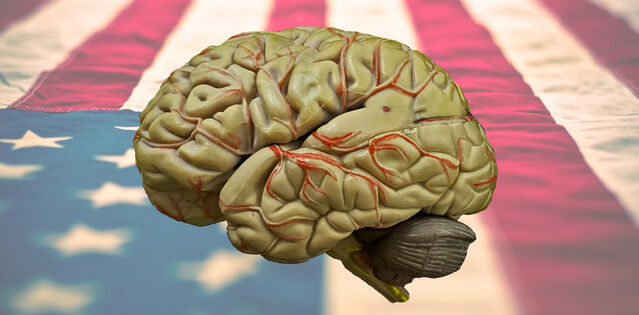Education
How to Repair the American Mind
America’s political disinformation and conspiracy belief crisis can be solved.
Posted January 19, 2021

“Every person we save is one less zombie to fight.” ― World War Z, 2013 film
The invasion of the U.S. Capitol Building by rioters and vandals on January 6 marked a significant moment in American history. It made clear that political propaganda and irrational beliefs have reached crisis levels. Thousands of people in Washington, D.C. that day, and many more elsewhere in America, are now so hypnotized by blatant lies and objectively nonsensical beliefs that they are willing to break laws and even threaten others with violence, at risk of their own safety and freedom.
Gullibility, fanaticism, and political trickery are not new in America, of course. But it all feels faster, louder, and more dangerous these days. One no longer needs to be a charismatic apocalyptic preacher with a brick-and-mortar church or a well-financed politician to invade minds at a steady clip. Today anyone with a Facebook or Twitter account has the potential power to ignite a wildfire of public lunacy.
The Capitol insurrection was a tornado strike of swirling irrational beliefs, a self-inflicted wound for the country that never should have happened. A sitting U.S. president and his allies used television, radio, and social media to weaponize some of the most gullible people in America. The key instruments of modern communication could be informing, entertaining, and uplifting us almost exclusively. Increasingly, however, they are maliciously exploited to infect vulnerable people with mental viruses that transform them into deranged mission-focused zombies. With an avalanche of deepfake technology (synthetic video/audio media that is nearly impossible to identify as false) looming on the horizon, it can get much worse.
Our present course is unsustainable. It promises more crippling confusion, chaos, and disruption, perhaps more than America can endure. The only hope is to attack the source of the problem. But what is that source? What is the real root of the crisis and what is the best solution? Attempting to corral or mute those who promote bad beliefs will not work. New con artists will always emerge to fill the void and plenty of people are ready to take the bait.
The reason this problem of mass delusion and rampant disinformation can exist to the degree it does may be because too many American minds are incapable of handling close encounters of the irrational kind. Vast numbers of people don’t know how to think critically and are insufficiently aware of how easy it can be for anyone, regardless of formal education or intelligence, to be lured into a bogus belief. This abundance of unprotected minds provides the necessary foundation for our growing crisis. Minus many millions of people in a vulnerable state, empty claims and ridiculous beliefs could not rage across the land collecting converts with the ease they do now.
Are you skeptical of the claim that America is in the midst of a critical thinking crisis? Consider that many (possibly most) of the January 6 rioters were QAnon believers. Going all-in with QAnon means believing that a long list of celebrities and elites—including Lady Gaga, Bill Gates, Joe Biden, and Tom Hanks—operate an international satanic cannibalistic child sex-abuse organization. It is a claim so extraordinary that it can almost serve as the perfect litmus test for the pathological absence of critical thinking.
QAnon is a movement with no clearly identified founders or leaders and no formal doctrine. It is a big-tent/grab-bag of many old and new conspiracy theories that accommodates a long list of suspicions, fears, resentments, and prejudices. QAnon is the Costco of conspiracy theories, the Walmart of delusions: “Whatever you want, we got it.” It also has a Da Vinci Code element that seems to appeal to many believers who excitedly search for clues and follow online crumbs toward big “revelations.” Despite the absence of any credible evidence and the overwhelming unlikeliness of it all, the combination of fuzziness, inclusiveness, and flexibility is working. QAnon has vacuumed up millions of unprepared minds in recent years.
According to a recent NPR/IPSOS national poll, less than half (47 percent) of Americans say QAnon’s core claims are false. Seventeen percent of US adults—millions of voting-age citizens—admit to believing. Also alarming, 37 percent are “unsure.” Imagine being on the fence about whether Tom Hanks and Beyoncé are working with Satan to traffic child sex slaves around the world.
As if it were not interesting enough already, some people include lizard aliens in the QAnon recipe. These infiltrators from outer space supposedly include Queen Elizabeth, George W. Bush, and Barack Obama. The usual claim is that they are either shapeshifters or merely hiding beneath human skinsuits. This is not how the 21st century was supposed to be going for us. As a child nurtured on Star Trek reruns, I imagined our species solving poverty, ending war, and colonizing other worlds by now. Silly me. Here I am today discussing a popular belief that reptilian extraterrestrials reside in Buckingham Palace.
What can be done to meaningfully address the poor state of the American mind? Is there a way to alleviate so much politically oriented blindness to reason? How can we prevent QAnon and other such beliefs from corroding our nation’s collective sanity to the point of no return? Unfortunately, there is no quick fix available. Once people have tumbled down a rabbit hole as wide and deep as that one, reorienting or deradicalizing them is difficult. For some, it may be near impossible. Add to that the problem of social media’s scary ability to supply a seemingly infinite supply of rabbit holes. But there is a preventive treatment for all of this. Most won’t like it because it’s slow and involves a lot of work. But it is a solution, probably the only one we can be sure would have a good chance of success.
Elevating critical thinking through education is the solution. Playing the long game of education is the only way to deny the irrational-belief beast the steady supply of victims it depends on. Extreme political manipulation, social media madness, QAnon, and other 21st-century American delusions would dry up and shrink to insignificance without a deep pool of unquestioning believers ready for indoctrination. Those who understand the need to stop America’s slide into ever-deepening irrationality must push our society to raise up new generations of thinking citizens who are capable of identifying and shrugging off baseless claims. The American mind can be repaired long-term, but only by teaching the skills and principles of critical thinking to every child. I am aware of the cliché-like feel that comes with citing education as our only salvation from a big problem. But in this case, it may be the only way.
Making critical thinking a national educational norm may be the cognitive vaccine America needs to have a fighting chance of reclaiming and maintaining its sanity. Good thinking prevents and alleviates bad thinking. Young students can be taught reason and skepticism as basic life skills. This would not be the kind of education that involves learning a bunch of facts for later regurgitation. Critical thinking is more like learning a trade. As one might train to weld or build furniture, one can learn how to think well out in the real world.
Critical thinking courses for all elementary, middle school, and high school students might include age-appropriate lessons on how to ask the right questions when confronted with an unusual or important claim; a review of common logical fallacies (explained with an emphasis on their relevance to everyday experiences); a basic survey of the surprising but normal processes of a human brain (including how we see, why memory is unreliable, how the subconscious mind influences conscious thinking, etc.); historical review of past mass delusions, frauds, and costly mistakes rooted in poor thinking; and discussions about the many positive benefits of good thinking (increased odds for a safer, more productive and efficient life).
Given its importance to individual and national health, why not teach critical thinking in every school, every day? Why not give it the same attention and emphasis as reading, mathematics, the Pledge of Allegiance, or anything else? As a parent and former teacher, I have seen how easily young students can pick this up. With guidance and encouragement, children can become highly proficient at thinking their way through complex claims, recognizing potential problems of perception, and spotting bias and lies. From the earliest ages possible, children in the U.S., and all countries, should be taught thinking skills because it will serve them well throughout their entire lives. It also just may save our civilization from implosion one day.
Having written several books and given many lectures and interviews on this topic, I know from experience that some people cringe, if not shriek in horror, at the thought of teaching critical thinking to 10-year-olds. But these concerns seem rooted in a misunderstanding of what critical thinking is. To be clear, it is not a list of taboo beliefs or approved ideas. Critical thinking is the means of figuring out if something makes sense and is likely to be true. Nothing is threatened apart from mistaken or unjustified beliefs that one hopefully would want exposed so as not to waste time, energy, or money on. Thomas Paine put it well: “It is error only, and not truth, that shrinks from inquiry.”
Anyone who opposes critical thinking education is effectively taking a position against reason and reality. Considering the current American landscape, this is inexcusable stark negligence. We cannot continue to fail so many children. They need the necessary tools to be able to navigate the increasingly complex and foreboding information jungles of 21st-century civilization. We owe students better than leaving them to exit schools on graduation day as soft targets for con artists and victims-in-waiting for delusion peddlers.
Critical thinking is viewed by some as code for condescension and elitism. This is another unfair judgment. No one owns a patent on thinking well. No one can keep this from you if you want it. Active critical thinking is a choice to try to get most things right most of the time. It is too useful, too vital today, to be left to university philosophy classes or rejected as a sign of intellectual snobbery.
Critical thinking is a collection of down-in-the-trenches people skills that are freely available to everyone. It’s about doing the work to figure out important things based on reason more than emotion and on analysis more than trust or tradition. It also means reevaluating conclusions and changing your mind when it makes sense to do so. Put simply, critical thinking is a conscious attempt to dodge lies and false beliefs while moving in the general direction of truth and reality. There is no more reliable safeguard against becoming someone’s fool or the sad pawn of an empty fantasy.
This is on us, the grownups. Adults who see the value and need for teaching reason-based, independent thinking to all children must act. Push politicians, school boards, and parents to prepare children for the countless lies, irrational temptations, and cognitive landmines they will encounter in life. What else can we do? The U.S. government cannot outlaw the inclination to believe nonsense. Regulations won’t purge the internet of every lie. Our brains are not going to suddenly evolve beyond their natural tendencies to lead us astray when it comes to perceiving and calculating reality. The answer lies with us. Teach our children thinking skills so that they can be their own editors and fact-checkers. Children who grow up in this century must be their own guardians of truth. But they will fall short unless someone cares enough to teach them how.
Books about critical thinking:
- Think: Why You Should Question Everything, by Guy P. Harrison
- The Demon-Haunted World: Science as a Candle in the Dark, by Carl Sagan
- The Skeptics' Guide to the Universe: How to Know What's Really Real in a World Increasingly Full of Fake, by Steven Novella
- Critical Thinking: Pseudoscience and the Paranormal, by Jonathan C. Smith
- The Believing Brain: From Ghosts and Gods to Politics and ConspiraciesT, by Michael Shermer
- Caveman Logic: The Persistence of Primitive Thinking in a Modern World, by Hank Davis
- Scientific Paranormal Investigation: How to Solve Unexplained Mysteries, by Ben Radford
Recommended magazines:
- Psychology Today
- Skeptic
- Skeptical Inquirer
- Free Inquiry




